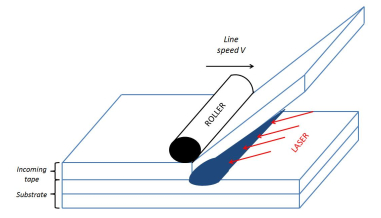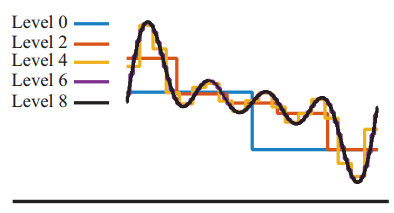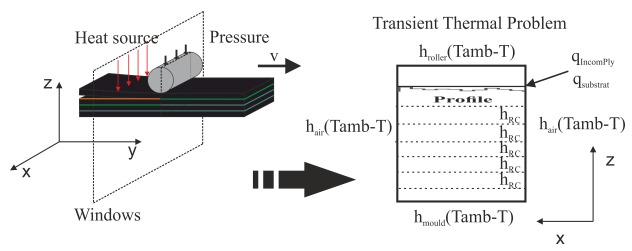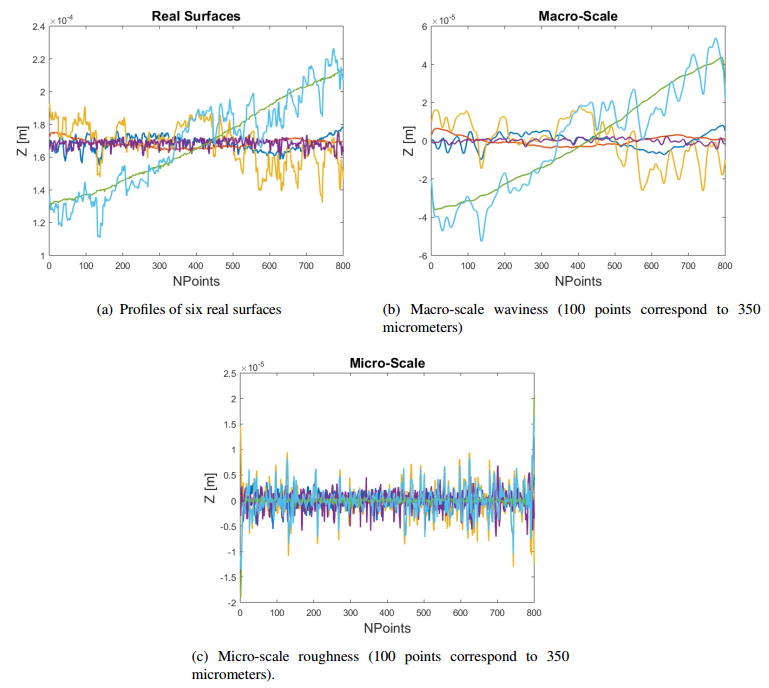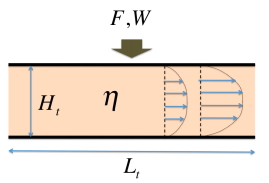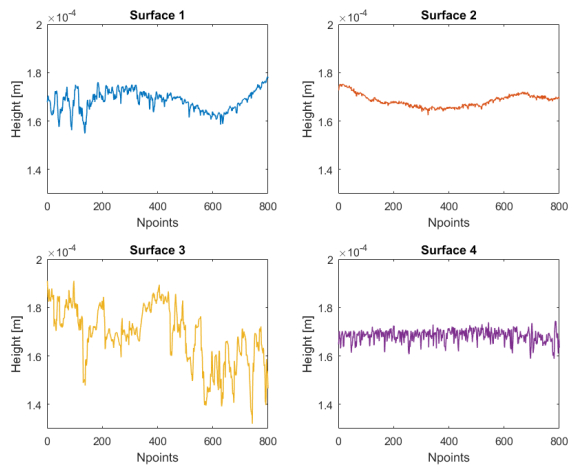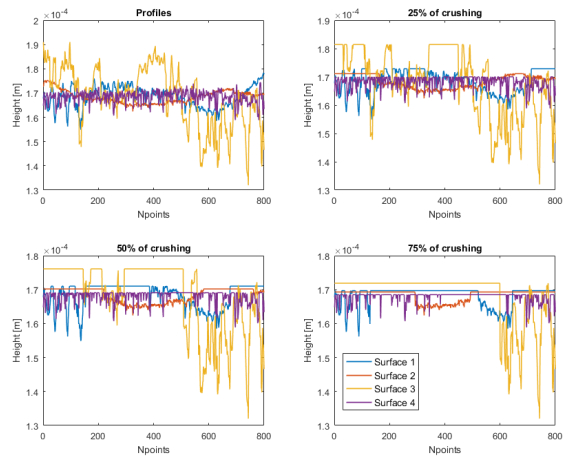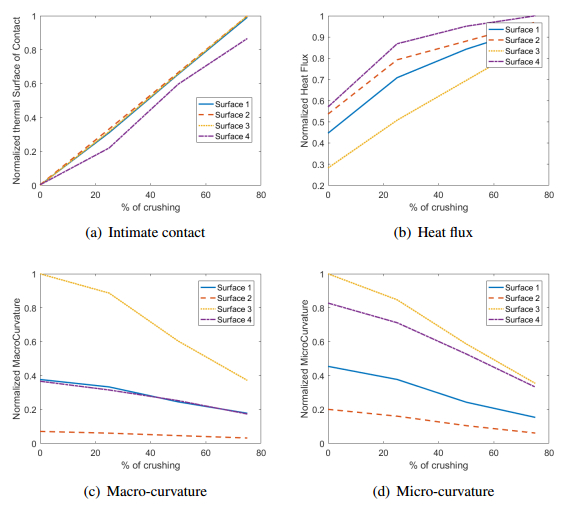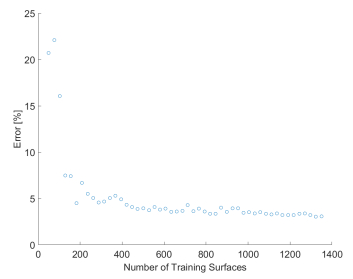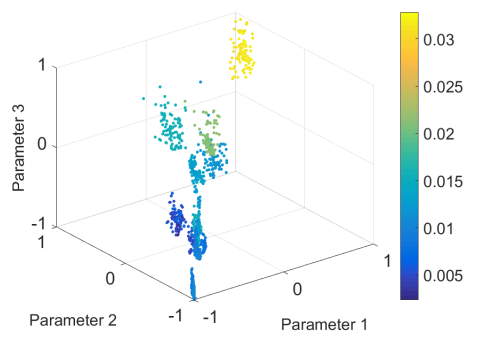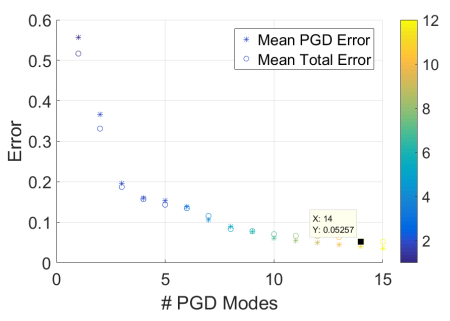Many composite forming processes are based on the consolidation of preimpregnated preforms of different types, e.g., sheets, tapes, .... Composite plies are put in contact using different technologies and consolidation is performed by supplying heat and pressure, the first to promote molecular diffusion at the plies interface and both (heat and pressure) to facilitate the intimate contact by squeezing surface asperities. Optimal processing requires an intimate contact as large as possible between the surfaces put in contact, for different reasons: (i) first, a perfect contact becomes compulsory to make possible molecular diffusion at the interface level in order to ensure bulk properties at interfaces; (ii) second, imperfect contact conditions result in micro and meso pores located at the interface, weakening it from the mechanical point of view, where macro defects (cracks, plies delamination, etc.) are susceptible of appearing. As just indicated, the main process parameters are the applied heat and pressure, as well as the process time (associated with the laying head velocity). These parameters should be adjusted to ensure optimal consolidation, avoiding imperfect bonding or thermal degradation. However, experiments evidence that the consolidation degree is strongly dependent on the surface characteristics (roughness). The same process parameters applied to different surfaces produce very different degrees of intimate contact. The present study aims at identifying the main surface descriptors able to describe the evolution of the degree of intimate contact during processing. That knowledge is crucial for online process control in order to maximize both productivity and part quality.
1.
Introduction
Biodiversity (i.e. biological diversity) is defined as "the variability among living organisms from all sources including, inter alia, terrestrial, marine and other aquatic ecosystems and the ecological complexes of which they are part; this includes diversity within species, between species and of ecosystems." [1]. Therefore, biodiversity refers to diversity at multiple scales of biological organization (genes, populations, species, and ecosystems) and geographic scale (local, regional, or global) [1]. Usually, three levels of biodiversity are discussed viz. genetic, species, and ecosystem diversity [2]. Biodiversity is the foundation of ecosystems, which provide different services that are fundamental for human well-being (cf. basic material needs for a good life, health, security, good social relations, and freedom). These include provisioning services (e.g. food, water, and fibre), regulating services (e.g. regulation of climate, diseases, and water quality), supporting services (e.g. soil formation, photosynthesis, and nutrient cycling) and cultural services (e.g. recreation, aesthetic enjoyment, spiritual fulfilment). The Intergovernmental Science-Policy Platform on Biodiversity and Ecosystem Services (IPBES) introduced recently a new concept, viz. Nature's Contributions to People (NCP) [3], which is closely related to and builds on the ecosystem services concept.
Biodiversity loss is one of the most pressing challenges for humanity. For that, biodiversity conservation is addressed in many Sustainable Development Goals (SDGs) such as SDG 2 "Zero Hunger" and SDG 15 "Life on Land" [4]. The most important drivers of biodiversity loss are habitat change (e.g. land-use changes), overexploitation (e.g. over-hunting, over-fishing), climate change, pollution (nitrogen, phosphorus), and invasive alien species [1].
Biodiversity loss is a particular challenge in regions where the anthropogenic and natural pressure on fragile ecosystems is high such as the Sahel and West Africa regions. Evidence shows that the impacts of climate change (CC) will be high in Sub-Saharan Africa [5,6,7,8,9]. In the context of SSA, the Sahel and West Africa regions seem particularly vulnerable to climate change [9,10,11,12].
Pastoralism is one of the most important drivers of land use in West Africa. Indeed, the share of land under permanent meadows and pastures in the land area ranges from 4.88% to 43.55%, while their share in agricultural land ranges from 13.92% to 73.79%, in Benin and Guinea, respectively (Table 1).
The role of pastoralism in biodiversity decline is a matter of academic debate. Some scholars point out pastoralism as a cause of land degradation and desertification [13,14], and deforestation [15,16]. Many of these negative impacts are due to overgrazing [13,14]. However, other scholars reject this claim about the link between pastoralism and desertification [17] or highlight that pastoralism is compatible with biodiversity conservation [18,19].
In this context, different scholars point out that the sustainable management of biodiversity in rangelands and pastures requires investment in research, innovation, and development [20]. Nevertheless, there has been so far no comprehensive assessment of research in this field in the West Africa region. To fill this gap, the present systematic review analyses the state of research on the nexus between biodiversity and pastoralism in the region. In particular, it explores the relationships between pastoralism, on the one hand, and plant diversity, animal diversity, and ecosystem diversity, on the other hand. The paper also analyses the bibliometrics of the research field.
2.
Methods
The paper draws upon a systematic review of all documents indexed in the Web of Science (WoS) and follows the PRISMA guidelines (Preferred Reporting Items for Systematic Reviews and Meta-Analyses) [23]. A search was carried out on 18 March 2021 using the following Title-Abs-Key search query: (pastoralism OR pastoralist OR pastoral OR grazing OR rangeland OR pasture) AND (diversity OR diverse) AND ("West* Africa" OR Sahel OR Benin OR Burkina OR "Cape Verde" OR "Cabo Verde" OR Gambia OR Ghana OR Guinea OR "Guinea-Bissau" OR "Ivory Coast" OR "Côte d'Ivoire" OR Liberia OR Mali OR Mauritania OR Niger OR Nigeria OR Senegal OR "Sierra Leone" OR Togo). The initial search yielded 205 documents. The selection of the documents to be included in the systematic review was informed by the methodology suggested by El Bilali [24]. Table 2 describes the selection steps and process. Particularly, three inclusion/eligibility criteria were considered: geographical coverage (viz. the document deals with at least one West African country); thematic focus (viz. the document deals with both biodiversity and pastoralism); and document type (viz. only articles, chapters or conference papers were selected; letters to editors, commentaries and/or notes were discarded). Only the documents that meet all the three criteria were included in the systematic review.
Following the screening of titles, 34 documents were excluded as they do not refer to West Africa; documents covering wider geographical areas (e.g. Sub-Saharan Africa, Sahel) or those where the geographical scope is not reported in the title were kept for further analysis. Further 24 documents were excluded following the scrutiny of abstracts as they do not meet at least one of the eligibility criteria. For instance, some documents refer to Lasius niger, an ant species, Aspergillus niger, a fungus, Scarus niger, a fish species, or Pterostichus niger, a carabid beetle, that have nothing to do with 'Niger' country. Furthermore, 'Guinea' refers sometimes to some plants (e.g. Guinea grass), animals (e.g. Guinea pigs), or Papua New Guinea instead of the two Western African countries (viz. Guinea and Guinea-Bissau). Senegal refers to some plants such as Acacia Senegal. Additionally, 74 documents were discarded following the analysis of full-texts, including 2 reviews [20,25]. Therefore, only 73 documents resulted eligible and were included in the systematic review (Table 3); these include 71 journal articles and 2 proceedings papers.
The selected documents underwent both bibliometric and topical analyses. Bibliometrics regarded sources/journals, research areas, authors, and affiliation organizations and countries as well as the geography of the research on the nexus between pastoralism and biodiversity in West Africa. The topical analysis focused on the linkages between biodiversity (viz. plant diversity, animal diversity, and ecosystem diversity) and pastoralism.
3.
Results and discussion
3.1. Bibliographical metrics and research geography
The bibliometrics of the selected documents are shown in Table 4. The annual output of publications in the period 1998-2020 ranges from nil in 2000 and 2002 to a maximum of 8 in 2015 and 2018. Meanwhile, the average annual output over the same period is about 3 documents. There is generally an upward trend, which might suggest an increasing interest in the nexus between pastoralism and biodiversity.
As for sources, the bibliometric analysis shows that the maximum number of documents was published in the journals Flora and Livestock Science (4 documents each). This might suggest that the starting point in studies on biodiversity-pastoralism nexus is oftentimes biodiversity (cf. Flora) or pastoralism (cf. Livestock Science). Nevertheless, the research findings were published in 56 further sources and journals. Most of the selected documents can be linked to the research areas of ecology (24 documents), environmental sciences (16 documents), and plant sciences (14 documents). However, the selected documents can be categorized in further 28 research areas (e.g. agriculture, forestry, agronomy, environmental studies, biodiversity conservation, geosciences, entomology, ornithology, veterinary sciences, biotechnology, geography, soil science, water resources, economics), which suggests that the research field is multidisciplinary.
The bibliometric analysis suggests that the most productive, prominent authors are Pierre Hiernaux (8 documents) and Luc Hippolyte Dossa (6 documents). Nevertheless, the fact that 254 authors have only one article might indicate a lack of consistency and specialization in the research field.
The analysis of affiliation countries suggests that the most active countries in the research field are France (20) and Burkina Faso (19). Affiliation West African countries also include Benin (8 documents), Senegal (7 documents), Mali (6 documents), Nigeria (6 documents), Niger (4 documents), and Ghana (2 documents). However, only 5 West African countries (viz. Burkina Faso, Benin, Senegal, Mali, and Nigeria) feature on the list of top-ten countries. A large share of documents is authored by researchers based outside West Africa mainly in Europe (e.g. France, Germany, Belgium, England, Sweden, Denmark, Netherlands) and North America (e.g. USA). Therefore, it comes as no surprise that many of the prominent organizations are based outside West Africa, mainly in France, and they include Institut de Recherche pour le Développement – IRD (France), Centre de coopération internationale en recherche agronomique pour le développement – CIRAD (France), Centre National de la Recherche Scientifique – CNRS (France), Swedish University of Agricultural Sciences (SLU), Université de Montpellier (France), Institut national de recherche pour l'agriculture, l'alimentation et l'environnement – INRAE (France), Université Catholique Louvain (Belgium), Université de Toulouse (France), University of Bonn (Germany), and Wageningen University and Research (Netherlands). The list also includes some international research centres such as the Consultative Group on International Agricultural Research (CGIAR), the International Livestock Research Institute (ILRI), and the International Crops Research Institute for the Semi-Arid Tropics (ICRISAT). However, many domestic organisations are active in the research field such as in Benin (e.g. Université d'Abomey-Calavi, Université de Parakou) and Burkina Faso (e.g. University of Ouagadougou, Institut de l'Environnement et de Recherches Agricoles – INERA, Université Polytechnique de Bobo-Dioulasso).
There are huge differences among West African countries in the research field. Indeed, the analysis of the geography of the research suggests that research on pastoralism-biodiversity nexus is mainly performed in Burkina Faso and Benin (Table 5). This is quite surprising, and somehow unexpected since Burkina Faso and Benin are neither among the largest nor the most populous countries in the region. Meanwhile, no article deals specifically with this subject matter in Cape Verde, Côte d'Ivoire, Gambia, Guinea, Guinea-Bissau, Liberia, Mauritania, and Sierra Leone. This suggests a huge research gap in these countries. Moreover, there is no single study on pastoralism-biodiversity nexus in the whole of West Africa but there are some multi-country studies that cover countries in West Africa, Sahel, Sub-Saharan Africa, or even some non-African countries.
3.2. Topical analysis
The analyzed scholarly literature presents different combinations of livestock species and pastoralism-related land uses (Table 6). Indeed, different types of pastoralism are analyzed such as agro-pastoralism, sylvo-pastoralism and agro-sylvo-pastoralism, which denotes the diversity of land uses in pastoral areas in West Africa. The livestock species addressed include cattle, goats, sheep and camels. The latter follows a kind of gradient, moving from cattle and sheep in the south of the region to goats and camels that are more adapted to arid and harsh conditions that prevail in the northern Sahel and Sahara. However, in many articles, there is no specification of neither the pastoralism-related land use nor livestock species. Moreover, studies comparing the effects of different types of land uses and/or various livestock species in the same bio-geographic context are generally lacking in West Africa.
3.2.1. Pastoralism and plant diversity
Pastoralism can affect both species richness and abundance. In this respect, different scholars dealt with the diversity of grasses [38,44,54,84] and fodder trees [26,29,56] across the region. Ouachinou et al. [42] recorded 116 fodder plant species during ethnobotanical investigations with cattle breeders across Benin. Naah and Guuroh [48] identified 135 species of forage plants in the area ranging from northern Ghana to central Burkina Faso. Sewade et al. [56] enumerated 48 fodder trees, belonging to 17 families and 37 genera, in the Sudano-Guinean transition zone of Benin. Koura et al. [26] show that smallholder goat farmers in the sub-humid areas of Benin use different types of tree and shrub leaves as supplements. Madsen et al. [91] identified 131 common vascular plant species in two reference sites located in traditionally managed agro-pastoral landscapes of the Sahelian and Sudanean zones of Burkina Faso. Antwi et al. [39] argue that species overexploitation for productive purposes and loss of traditional values are drivers of biodiversity loss. Naah and Guuroh [48] show that both ethnicity and environmental harshness (e.g. aridity) can markedly shape the body of local ecological knowledge (LEK) of agro-pastoralists about forage plants in Ghana and Burkina Faso.
Many scholars highlight that pastoralism and grazing reduce species abundance and/or richness. Antwi et al. [39] found that species diversity was the lowest in grazed fields, compared to sacred groves, fallow fields and crop fields in Ghana. Sanou et al. [44] argue that intensive grazing resulted in a reduction in species diversity and a change in species composition with a decrease in the richness of perennial grasses. The effect of pastoralism on species richness and abundance is particularly true for herbaceous species [36,76], and a distinction between herbaceous and woody species is necessary in this regard. For instance, in their analysis of vegetation changes over the past decades in savannah ecosystem in south-eastern Burkina Faso, Leßmeister et al. [36] found no change in species composition and richness of woody vegetation but their abundance decreased; meanwhile, there was a considerable change in the species composition of herbaceous vegetation and species richness increased. In particular, grazing leads to a decrease in the abundance of fodder herbaceous species preferred by the livestock [36]. However, Hiernaux [97] found no clear relationships between species response to grazing (in terms of species composition and spatial distribution) and palatability in Sadore, Niger. Dendoncker et al. [29] observed a loss of species diversity combined with a shift in the composition of species, towards more shrubs with respect to trees, over the period 1965-2018 in the Sahelian sylvo-pastoral zone of Ferlo (Senegal). Similarly, referring to the same area of Ferlo, Dendoncker et al. [61] show a decline in woody species diversity and saplings numbers between 1955 and 2012. Referring to Burkina Faso, Mueller [68] warns that "In many areas, tiger bush vegetation had completely disappeared or had been dramatically reduced over the last 50 years probably as a result of increased anthropogenic pressure and grazing. Still existing tiger bush stands are often degraded" (p. 153). In Kotchari area (south-eastern Burkina Faso), Sawadogo et al. [69] show that pastures located outside the protected area (W National Park) tend to be the most degraded with problems in trees regeneration and a decrease of perennial herbaceous species.
Grazing does not only affect the diversity of aboveground vegetation but also the composition of soil seed banks [44]. Indeed, heavy grazing also changes the composition of the soil seed bank in pastures and rangelands by increasing the ratio of herbaceous, annual species to woody, perennial species [44]. Devineau [94] argues that cattle grazing contributes to the dispersal of the seeds of weeds and woody species in Bondoukuy (south-western Burkina Faso) through cow dungs, which might even contribute to increasing species abundance and/or richness in pastures. Moreover, also effects on landscape and habitats caused by pastoralism (especially intensive grazing) can have feedback loops on plant biological diversity in pastures and rangelands.
However, the impact of pastoralism depends on grazing intensity [36,44,75]. It also depends on the feeding behaviour and fodder intake of the different livestock species (cattle, sheep, goats) [40]. Hiernaux et al. [74] argue that changes in grazing pressure, land use, and soil fertility triggered changes in species composition with a strong reduction in diversity from rangelands to fallows in Fakara region (Niger).
While many scholars highlight the negative effects of pastoralism on biodiversity, Zinsstag et al. [57] point out the positive role of pastoralism in the conservation of biodiversity and put "it appears that pastoral social ecological systems are hotspots of cultural and biological diversity. They are multifunctional in that they generate diversified sources of income and contribute to sustained natural resource management" (p. 693). In this respect, Devineau and Fournier [83] argue that cattle herding does not affect herbaceous species richness in Sudan-type savannah (Bondoukuy, western Burkina Faso) and that there is no clear evidence of lower species richness due to this anthropogenic disturbance. Similarly, Jamnadass et al. [84] suggest that grazing has not caused a loss of the genetic diversity of wild forage species in western Niger. Traoré et al. [65] found that grazing was associated with more tree species and stem density in the Sudanian woodland of Burkina Faso and recommend revising the current regulation that prohibits grazing to accommodate herders' interests. Likewise, Savadogo et al. [79] argue that grazing tended to favour perennial grasses diversity over a 10-year period (1994–2003) in the Sudanian savannah-woodlands of Burkina Faso.
3.2.2. Pastoralism and animal diversity
The selected documents show the diversity of livestock species raised by pastoralists such as cattle [27,31,34,35,45], goats [40], sheep [40,51] and camels [53,58]. Ayantunde et al. [72] consider livestock diversity as a central issue in determining the sustainability of pastoral systems in West Africa. Scholars enumerated numerous local livestock breeds such as Lagune, Somba, Pabli, and Borgou [31] and Keteeji, Jaliji, Bodeji, Tchiwali, and Gudali [45] cattle breeds in Benin.
Many articles point out that indigenous livestock genetic resources are being eroded [27,31,34]. One threat to indigenous livestock breeds is represented by uncontrolled mating. For instance, Ahozonlin and Dossa [27] point out that uncontrolled mating, especially in free-roaming pastoral systems, favoured Lagune cattle breed admixture with zebus in southern Benin. Likewise, Scheper et al. [31] argue that climate change and, consequent intensification of, transboundary transhumance favoured hybrid cattle breeds to the detriment of indigenous breeds (viz. Lagune, Somba, Pabli, and Borgou) in Benin. Abdussamad et al. [58] highlight that dromedaries in the Nigeria-Niger corridor exhibit a high genetic diversity, which might be due to the continuous gene flow with other dromedary populations during transhumance. However, any programme for the conservation of animal genetic resources or their improvement should consider the diversity of goals and preferences among livestock keepers [51].
The erosion of the local livestock genetic resources goes hand in hand with that of the traditional, indigenous knowledge associated with local, indigenous breeds [45]. Interestingly, Volpato et al. [53] argue that the demise of pastoral livelihoods represents a serious threat to piebald (painted) camels across the Sahara and Sahel. According to Ayantunde et al. [72], "Pastoralism is not only a livestock-based livelihood strategy but also a way of life with socio-cultural norms and values, and indigenous knowledge revolving around livestock" (p. 30). Naah and Braun [37] point out that agro-pastoralists in northern Ghana and southern-central Burkina Faso exhibited extensive local ecological knowledge on habitat types, forage species diversity, abundance trends, and ecological drivers. Houessou et al. [34] show that herders in Benin were able to distinguish ten different traditional cattle breeds and add that herders' classification was more accurate in distinguishing breeds within the zebuine subspecies than modern techniques such as body measurements. Therefore, they recommend that "while metric measurements and molecular genetic analyses are promising approaches to fill the knowledge gap on the diversity of local farm animal genetic resources, they should integrate livestock herders' traditional knowledge for more precision". However, local knowledge is not always validated by and consonant with modern science as shown by Abdussamad et al. [58] in the case of genetic variation and colour phenotypes of dromedaries in the Nigeria-Niger corridor.
Apart from the biological diversity of livestock species, some documents deal with the diversity of insects and arthropods in pastures and rangelands such as termites [33,65,80], fruit-feeding insects [71,82], butterflies [87] and tsetse flies [93]. Using fruit-feeding insects as ecological indicators of ecosystem health, Akoudjin et al. [71] argue that grazing has a lower impact than cropping on ecosystem health in Koro (south-western Burkina Faso). Traoré and Lepage [80] found that the diversity of epigeal termite mounds was not affected by livestock grazing in the Sudanian savannah-woodland in Tiogo State Forest (Burkina Faso). However, de La Rocque et al. [93] conclude that land-use change caused by higher cattle densities and increased human activity were associated with increased density of tsetse flies in an agro-pastoral area of Burkina Faso.
Pastoral activities have an impact not only on the diversity of domesticated animals but also on wildlife [46,60,73]. Indeed, pastoralism can create competition with wild animals and, consequently, affect their diversity and abundance [46,60]. For instance, Brugière et al. [60] suggest that pastoralism (especially mobile, transhumant pastoralism) may explain the extinction pattern of large predators (viz. lions, cheetahs, and wild dogs) in Western and Central Africa. Livestock species also compete with wild large herbivorous mammals [46].
Pastoralism can also affect the populations of birds in West Africa [41,73,86,92]. For instance, Manu et al. [73] suggest that bird species richness and diversity are threatened by fire, grazing and shifting agriculture in important bird area sites in south-eastern Nigeria. Thiollay [86] postulates that hunting, and habitat degradation and fragmentation, mainly due to intensive cattle grazing and woodcutting, have contributed to a decline of the passerine bird community in the Sudanian belt of Burkina Faso. However, Muhammad et al. [41] suggest that small-scale habitat modification and anthropogenic activities, such as farming and grazing, did not have a notable impact on the birds' population in Dutse area (Nigeria), which might suggest that grazing and pastoralism are compatible with birds conservation.
3.2.3. Pastoralism and ecosystem diversity
Pastoralism affects landscapes and ecosystems mainly through impacts on habitats. The effect on natural habitats is, in turn, due to the use of pastures and rangelands, and land and water resources that they encompass. Therefore, effects on landscapes and ecosystems in pastures and rangelands depend, among others, on pastoral practices and grazing intensity. Similarly, landscape changes can affect pastoral communities by hampering or making difficult access to grazing land [50]. Koura et al. [63] point out that all cattle farm types (viz. large integrated agro-silvopastoral, small agro-silvopastoral, pastoral and silvopastoral) reported increased difficulty in access to pastures in the periphery of Cotonou (Benin) due, inter alia, to the increase in crop farming and urbanization. Badji et al. [66] argue that pastures and woodlands are being overexploited and at risk of disappearing due to cropland extension and uncontrolled wood-cutting for firewood and charcoal in the Senegalese groundnut basins. Difficult access to some pastures increases pressure on the remaining accessible rangelands (even marginal ones), which might determine their degradation [74].
Leßmeister et al. [36] show that the effects of land-use intensification (e.g. agriculture, pastoralism) differ according to vegetation types (woody vs. herbaceous) and vegetation layers (tree and shrub layers) in south-eastern Burkina Faso, which reinforces the need for landscape-based studies that consider different vegetation types and layers. Nevertheless, the impact of pastoralism on landscape seems lower than that of cropping, fire and tree cutting. In this respect, Hiernaux and Gérard [95] put that "Except for the herb layer, little evidence was found of grazing influence on the vegetation structure and yield a few hundred metres away from livestock concentration points. On the other hand, the clearing of thickets for cropping led to severe soil erosion which threaten the resilience of 'brousse tigree'" (p. 147) in Mali and Niger.
In their analysis of the impact of agro-pastoral management practices on wind erosion in croplands in Niger, Pierre et al. [43] suggest that "… grazing might have mixed effects, probably further mediated by the mobility of livestock as a response to forage availability" (p. 800). Agro-pastoral management modifies surface characteristics by, among others, tillage and crop residue management practices, thus affecting wind erosion, which, in turn, affects soil structure and fertility [43]. In this respect, in the Gourma pastoral region (Mali), Dardel et al. [67] observed an increase in erosion and run-off processes in association with a decrease or stable vegetation cover over shallow soils in the period 1984–2011, which determined contrasted landscape changes. Meanwhile, in the agro-pastoral region of Fakara (western Niger), they observed a decreasing trend of herbaceous mass over the period 1994–2011 [67].
The effects of pastoralism on the landscape are also due to the mining and transport of nutrients embedded in biomasses such as fodders and manure [62]. Sanou et al. [44] argue that "Heavy grazing resulted in the disappearance of perennial grasses, a reduction in species diversity and a decrease in soil nutrients with increased soil depth" (p. 773). In this regard, Houessou et al. [35] recommend that mobile pastoralists in Benin adopt grazing and manure contracts with local crop and livestock farmers. Likewise, Diarisso et al. [62] suggest that "Better integration of crop and livestock production activities on farms and between farms offers a pathway to more efficient nutrient cycling with reduced nutrients losses" (p. 295). This is confirmed by Vall et al. [52] who found that farms in western Burkina Faso and northern Cameroon with a high level of association between livestock crop farming have better overall indicators of sustainability.
Apart from grazing pressure, the biological diversity in rangelands and pastures is also affected by soil and, especially, climatic conditions. Indeed, climate change is particularly affecting rangelands and pastures in the Sahel and West Africa regions [63,75]. Koura et al. [63] suggest that climate variability/change reduced the availability of fodder for cattle farmers in the periphery of Cotonou (Benin). Hiernaux et al. [75] note that woody populations in different rangeland sites in Gourma (Mali) were struck by the 1983-1984 droughts. Savadogo et al. [79] conclude that both climatic conditions and disturbances (viz. grazing, selective tree cutting, fire) influence the composition and diversity of herbaceous species in the Sudanian savannah-woodland ecosystem of Burkina Faso. Meanwhile, Jamnadass et al. [84] argue that the impact of grazing on the genetic diversity of wild forage species populations in western Niger may increase with increasing aridity.
Many scholars call for new models for the sustainable management of pastures and grasslands in West Africa and highlight the contribution of research in this regard. For instance, Jimoh et al. [30] call for a "paradigm shift in grassland research in Nigeria, from production-based to production-conservation driven. This shift would bring about a sustainable grassland management and utilization techniques that promote adaptation to local or global climate change, biodiversity conservation, ecosystem resilience, and sustainable livestock production".
4.
Conclusions
The article analyses in a comprehensive way the state of research on biodiversity-pastoralism nexus in West Africa. The review shows an increasing interest in the research field, especially in Burkina Faso and Benin. Nevertheless, a large share of documents is authored by scholars based outside West Africa, especially in Europe (e.g. France), which might suggest that more effort (in terms of financial and human resources) is needed to develop the research field in the region.
The topical analysis of the scholarly literature shows that the effects of pastoralism are rather mixed. They are context-specific and depend on many factors such as grazing intensity and livestock species. In general, pastoralism affects negatively plant species diversity, especially in terms of abundance, but there is a clear distinction between woody (trees and shrubs) and herbaceous species. However, grazing can contribute to seed dispersal. Likewise, pastoralism can affect the diversity of wild animals such as herbivorous mammals, predators and birds but also insects. While there is a general trend towards the erosion of indigenous livestock genetic diversity due to uncontrolled mating and cross-breeding (especially in mobile, transhumant pastoral systems), pastoralism and pastoral communities' traditional knowledge result fundamental in the conservation of local, indigenous breeds. The impacts of pastoralism on ecosystem diversity are mainly due to changes in land use. The present literature is far from being conclusive, which highlights the need for future studies on biodiversity-pastoralism nexus, especially cross-country and longitudinal comparative studies. The analysis of the different findings and their interpretations could be considered as complementary rather than mutually exclusive insights.
The impacts of pastoralism on biodiversity are context- and species-specific, as they depend on plant and livestock species, so further studies are needed to better understand the multifaceted biodiversity-pastoralism relations across West Africa. Moreover, the use of similar research methods, and eventually cross-country studies, can improve comparability and provide better guidance to decision- and policy-makers. The review suggests the importance of the sustainable management of pastures and grasslands in West Africa to achieve biodiversity conservation and ecosystem resilience, while preserving the livelihoods of pastoral communities. Such new models of sustainable management of pastures and grasslands should also promote adaptation to climate change.
The present systematic review was not without limitations. Indeed, the main limitation relates to the literature coverage. The review draws only upon quality, peer-reviewed scholarly literature (e.g. journal articles, book chapters and conference papers) indexed in the Web of Science (WoS) viz. SCI-Expanded (Science Citation Index Expanded), SSCI (Social Sciences Citation Index), A & HCI (Arts & Humanities Citation Index), ESCI (Emerging Sources Citation Index), CPCI-S (Conference Proceedings Citation Index - Science), and CPCI-SSH (Conference Proceedings Citation Index - Social Sciences & Humanities). It does not cover articles published in journals that are not indexed in WoS. Likewise, publications in conference proceedings and books that are not indexed in WoS were not considered in this systematic review. Moreover, the focus on scholarly literature means that grey literature (e.g. reports, discussion papers, working papers, policy briefs, magazine articles) was overlooked. A further limitation of the present systematic review, stemming from the analysed scholarly literature, is that it does not unravel the differentiated relations and interactions (cf. complementarities, synergies, conflicts) between the different pastoralism-related land uses (cf. agro-pastoralism, sylvo-pastoralism, agro-sylvo-pastoralism) and biodiversity conservation status in West Africa. The literature also falls short when it comes to disentangling the impacts of the different livestock species used in pastoralism on land degradation, habitat fragmentation and biodiversity loss. In this regard, comparative studies involving different livestock species in the same context are highly recommended to understand better the pastoralism-biodiversity nexus in West Africa.
Acknowledgments
This work was carried out within the project SUSTLIVES (SUSTaining and improving local crop patrimony in Burkina Faso and Niger for better LIVes and EcoSystems) of the DeSIRA initiative (Development Smart Innovation through Research in Agriculture) financed by the European Union (contribution agreement FOOD/2021/422-681).
Conflict of interest
All authors declare no conflicts of interest in this paper.









 DownLoad:
DownLoad:


